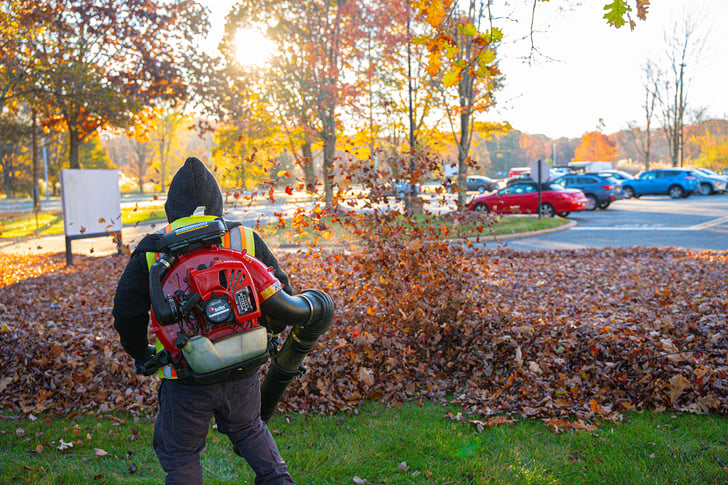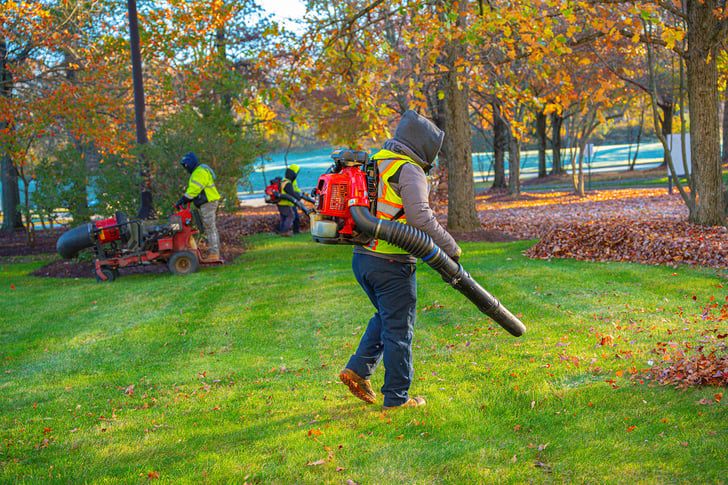Leaf removal is something professional landscapers provide our clients as a part of a comprehensive landscaping maintenance program. This service is as natural and necessary to us as mowing a lawn or neatly trimming hedges. However, property owners may not always see leaf clean-ups that way, especially with some recent ideas flowating around the internet about how we should be handling fallen leaves.
Our aim at Yellowstone Landscape is to shed light on topics like this. Sharing our collective decades of commercial landscaping experience helps property owners and managers keep their properties tidy, vibrant, and safe. Plus, the more you know about specific property services, the better you can plan your landscaping budget while providing a pleasant environment for your residents, employees, and guests.
We’ll cover safety concerns that leaf removal can eliminate, as well as the curb appeal aspect of fallen leaves. You’ll also get tips on when leaves fall in various parts of the U.S. and the steps your provider should take to maximize your landscape’s vitality with proper leaf removal.
We will also explain what happens if you leave leaves on the grass. Then, we’ll wrap up by explaining how a tree inventory helps property owners.
Safety Benefits of Leaf Removal
Safety Benefits of Leaf Removal
You could look at leaves from a couple of different angles. We’ll get to the “litter” angle, but let’s start with the snow and ice comparison.
Snow is nice to watch as its falling, but it causes safety hazards by covering up things on the ground. This leads to tripping hazards and the potential for objects to get damaged, like fire hydrants or newly installed plants, because they’re hidden. Snow then melts and can cause water damage or turn to ice, causing traffic accidents and pedestrian injuries.
Fallen leaves have the same negative potential.
Leaves can cover uneven ground, tree roots, and fallen limbs, which can be tripping hazards. Having leaves pile up on sidewalks could cause people to walk around them into the streets without looking both ways to avoid vehicles.
The longer leaves remain on sidewalks and streets, the wetter and slicker they can become. The result? Slip-and-fall accidents just like with ice on walkways and steps. And one study proved that vehicles braking on layers of leaves take twice as long to stop.
Leaves also lead to hazards most people never think about.
What Happens if You Leave Fallen Leaves On Grass?
While there are some benefits to leaving a few leaves on an individual lawn, generally, there are many more downsides, especially on larger properties with more significant leaf drop.
The following possibilities show what happens if you leave leaves on grass:
- Leaves can block sunlight and air, suffocating the grass
- Leaf piles provide shelter for harmful insects and rodents
- Wet leaves create a moist environment ideal for harmful fungal diseases
- Large amounts of leaves decomposing alter soil pH and nutrient levels
- Grass roots can be weakened, hurting turf health
- Hidden sprinkler head and hose damage from lawn equipment
- Leaves can prevent proper drainage
- Layers of leaves can delay soil warming and springtime grass growth
- Weakened grass is more susceptible to weeds
Cockroaches, centipedes, and spiders also like damp environments that come with leaves left on the grass. Then, there are also the aesthetics to consider.

Leaf Removal Provides Curb Appeal
The second angle you can take with leaf drop is the litter aspect. No one would want hundreds of napkins or candy wrappers scattered across their property, right? Not even if that litter magically decomposed after a few months. The same goes for leaves, despite them being natural, organic material.
The organic aspect comes into play as people and organizations like Yellowstone Landscape make efforts to protect the environment. On a small scale, leaves can be used by individual homeowners for mulch material or composting. On large commercial properties, keeping and utilizing all the leaves isn’t feasible. Some municipalities shred the leaves they collect, then offer the mulched leaves for free to the public.
The bottom line with commercial properties is that a neat and tidy appearance is a must.
Thousands of leaves on the lawn and piled up in landscape beds detract from a property’s curb appeal. This messy look will draw HOA resident complaints, just like overgrown grass, weedy mulch areas, or garbage bins left on the curb too long.
Cluttered landscapes aren’t appealing to potential hotel guests or retail shoppers either. Yes, adding trees to those commercial properties attracts consumers and increases property values. However, leaf clean-ups have to be part of any tree planting plan.

When Should You Plan Leaf Clean-Ups?
The good news is that if your landscape company is flexible, you can plan this service ahead of time and work it into your budget. Yellowstone offers clients budget-friendly options. They can choose to pay for a one-time clean-up after all the leaves are down or schedule up to five clean-ups to ensure the property looks its best every week.
Take a look at the following dates across the U.S. for leaf drop:
- Northeast: Leaves usually start dropping in late September to early October. Most trees are bare by mid-November.
- Midwest: Early October sees the first leaf drop. Nearly all leaves have fallen by early November.
- Southeast: The drop starts mid-October, and the final leaves fall around early November.
- West: Leaves in high elevations can begin falling in late September. Trees are usually bare by late October. Lower elevation leaf drop starts in mid-October, ending deep into November.
Mother Nature’s Clock Isn’t Always Exact
So, what factors can alter the above timelines? Temperatures, soil moisture, and the type of tree species come into play. Some species that experience leaf drop early include:
- Red Maples
- Black Cherry
- Ash Trees
Later drops occur in the following species:
- Live Oak
- Sweetgum
- Cottonwood
Climate change in various regions is also an ongoing factor that can delay or speed up leaf drop. Now, let’s look at the best ways to manage leaves.
The Steps Involved with Leaf Services
Having an estimated time frame for your property’s leaf removal puts you ahead of the game. You can go ahead and get penciled in on your provider’s schedule. This can help you avoid delays because leaf clean-ups are time-consuming in the fall, even for providers with the best equipment and teams.
The first step for leaf removal should be notifying residents, guests, and employees about the service. Some may want to park their vehicle elsewhere due to the often unavoidable dusty conditions. Communicate with your provider to try to schedule the service while fewer people are on the property.
Yellowstone uses a variety of tools and equipment, including rakes, blowers, tarps, mowers, and leaf vacuums. Each is needed due to varying property features. Rakes often work better than blowers in tight corners, for example. And for fountains and planters, there’s no substitute for thoroughly removing leaves by hand.
Our leaf crews follow local regulations for leaf disposal after we gather the leaves into a central location to vacuum them up. When possible, we mulch smaller volumes of leaves and leave safe amounts of the organic material on the lawn.
On one-time clean-ups, we check for any landscape damage due to leaves that were left on the ground too long (i.e., soggy turf) and we alert the property manager. The potential for problems is why we recommended at least two clean-ups.
Another way to get ahead of falling leaves is a simple tree inventory.
How a Tree Inventory Helps Property Owners
If your landscape company has a full-time arborist on staff, you can likely save a little money every year during leaf drop season. Certified arborists can do a tree inventory that gives you helpful insights into the most valuable plants on your property.
For leaf removal, this information helps give you a price range for fall clean-ups and a more exact timeline based on your property’s environment and tree species. Yellowstone arborists remind our clients of the leaf management costs they may overlook. It’s hard for folks to imagine a five-foot sapling turning into a 50-foot tree that drops two hundred pounds of leaves year after year.
A good arborist might also advise you on new plantings that utilize more evergreen trees.
This can avoid mountains of leaves on your grounds. Evergreens are wonderful for visual appeal, privacy, and noise reduction year-round. There are tradeoffs, though. You miss out on seasonal color changes, plus heavy snow and ice can break limbs, potentially damaging your property.
Extra insights you get from a tree inventory are below:
- Identify and take action on hazardous trees
- Improved pruning schedule (benefits trees and nearby plants)
- Provides a financial valuation of your trees
- Ensures regulation compliance
- Provides insurance documentation in case of claims
- Informs upcoming landscape or construction planning
- Prepares your property for future storms
- Can stop pest infestations before pests gain a foothold
If you’re already a Yellowstone client, just reach out to your account manager to discuss a tree inventory for your property.

Conclusion
Hopefully, you have a better understanding of why leaf removal is such a vital part of landscaping programs. Safety concerns like slippery conditions, disease-carrying pests, and even fire hazards are solid reasons to manage fallen leaves in a timely manner. What happens if you leave leaves on the grass is another concern. We noted several negative impacts this has on your valuable turf.
Just as critical is the diminished curb appeal resulting from messy leaves scattered all over a commercial property. As for utilizing decomposing leaves, it’s usually limited to small private gardens and individual planters. Check with your city to see if they offer mulched leaves to recycle for small-scale residential use.
The timeline and factors that affect leaf drop schedules should give you a headstart on your next fall clean-up. Plus, the clean-up steps we listed will help your community be ready when your provider arrives with leaf removal equipment.
As always, prevention is the best cure, though it’s tempting to overlook landscaping problems that aren't problems at the moment. But if you want to avoid hassles and unexpected costs when the leaves start piling up, we suggest scheduling a tree inventory as soon as possible.
If your provider doesn’t have a certified arborist on staff or you’re searching for a landscaping provider, contact Yellowstone Landscape today.


